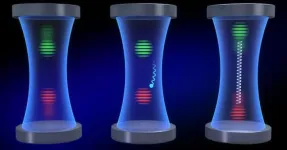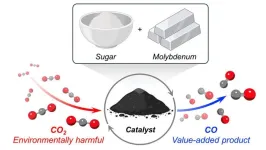(Press-News.org) In experiments in isolated villages in Honduras, researchers evaluated a new strategy for identifying individuals that could be targeted for effective information spreading. Their approach – more effective than random targeting, and also less time-requisite than approaches that require a complete understanding of the relevant social network – could have far-reaching policy implications in lower and middle-income countries. Understanding the structure and function of human social networks has yielded insights for exploiting social contagion – the spread of behaviors, attitudes, and practices through the members of a group. Such an approach could be used to disseminate important information, including public health interventions. However, deliberately fostering social contagion in face-to-face social networks requires identifying the structurally influential individuals, or “seeds,” to maximize information spillover. Although previous research has suggested several ways to identify these individuals, all existing methods have generally required mapping the entire social network’s structure, which is often expensive, time-consuming, and infeasible in real-world face-to-face situations. Through various field experiments, Edoardo Airoldi and Nicholas Christakis evaluated whether it’s possible to identify the best “seeds” within a group without having to map the entire network. Airoldi and Christakis performed a large, randomized controlled trial of network targeting among 24,702 people in 176 isolated villages in Honduras. The authors randomly assigned villages to friendship targeting methods, varying the fractions of households receiving a 22-month health education package and the method by which these households were chosen. According to the authors, a friendship targeting strategy leveraging the so-called “friendship paradox” of human social networks, which states that, on average, the friends of randomly selected individuals are more central to the social network than those who identify them, was able to substantially reduce the number of households that needed to be targeted to attain a specified level of village-wide uptake. “Deploying interventions through network targeting, without increasing the number of people targeted or the expense incurred, may enhance the adoption and spread of the interventions and thereby improve human welfare,” write Airoldi and Christakis.
For news outlets interested in building their own data visualizations, data usable to draw network pictures for 11 of the involved villages is available here. The authors will be happy to provide guidance regarding what subset of the data to use.
END
*FREE* Friendship-nomination approach identifies key villagers to diffuse health messages
2024-05-02
ELSE PRESS RELEASES FROM THIS DATE:
Chromosomal 22q11.2 deletion confers risk for severe spina bifida
2024-05-02
Chromosomal 22q11.2 deletions increase risk for meningomyelocele, one of the most severe and common forms of spina bifida, researchers report. According to the findings, this risk is mediated by the loss of Crkl, one of several neural tube expressed genes located on the 22q11.2 deletion interval, and this risk is only partially alleviated by folate supplementation. Meningomyelocele (MM) is a severe type of neural tube defect, which often requires pre- or post-natal surgical repair and can result in a variety of physical and developmental difficulties. Although the incidence of the condition has declined in recent decades, largely due to folic acid (FA) fortification, MM ...
Circadian clocks in the brain and muscles coordinate to support daily muscle function
2024-05-02
Molecular circadian clocks in the brain and muscle tissue cooperate to keep muscles healthy and functioning daily, according to a new study in mice. The findings could provide valuable insight into understanding the roles of circadian disruption in age-associated health issues and potential strategies to protect muscle function in aging individuals. A circadian molecular clock network is crucial for daily physiology and maintaining health. It’s thought that this network – which extends throughout all cells in the body – is hierarchically organized and coordinated by the brain’s suprachiasmatic nucleus (SCN), which receives daily light cues and synchronizes ...
*FREE* The effectiveness of early childhood education programs is scientifically uncertain
2024-05-02
Early care and education (ECE) programs – like Pre-Kindergarten (Pre-K) and Head Start – are widely regarded as effective public investments for reducing income- and race-based achievement gaps and helping children succeed in school with impacts extending well into adulthood. However, in a Policy Forum, Margaret Burchinal and colleagues present recent evidence suggesting that preschool impacts are not unequivocally positive and the science on the overall outcomes of these programs remains unsettled. According to Burchinal et al., more rigorous research is needed to understand how to design early education programs that produce long-term positive ...
Twisting and binding matter waves with photons in a cavity
2024-05-02
Precisely measuring the energy states of individual atoms has been a historical challenge for physicists due to atomic recoil. When an atom interacts with a photon, the atom “recoils” in the opposite direction, making it difficult to measure the position and momentum of the atom precisely. This recoil can have big implications for quantum sensing, which detects minute changes in parameters, for example, using changes in gravitational waves to determine the shape of the Earth or even detect dark matter.
In a new paper published in the Science, JILA and NIST Fellows Ana Maria Rey and James Thompson, ...
Sugar-based catalyst upcycles carbon dioxide
2024-05-02
A new catalyst made from an inexpensive, abundant metal and common table sugar has the power to destroy carbon dioxide (CO2) gas.
In a new Northwestern University study, the catalyst successfully converted CO2 into carbon monoxide (CO), an important building block to produce a variety of useful chemicals. When the reaction occurs in the presence of hydrogen, for example, CO2 and hydrogen transform into synthesis gas (or syngas), a highly valuable precursor to producing fuels that can potentially replace gasoline.
With recent advances in carbon capture technologies, post-combustion carbon capture is ...
Deeper understanding of malaria parasite sexual development unlocks opportunities to block disease spread
2024-05-02
For the first time, the developmental stages of the deadliest human malaria parasite have been mapped in high resolution, allowing researchers to understand this ever-adapting adversary in more detail than previously possible.
The study, published today (2 May) in Science, details the critical developmental stages of the malaria parasite, Plasmodium falciparum, using single-cell RNA sequencing. This gives detailed information on the life stages of this parasite as it matures, changing from an asexual state to a sexual state, which is necessary before the parasite can be transmitted to mosquitoes.
The research from ...
Breaking ground: Investigating the long-term effects of early childhood education
2024-05-02
EMBARGOED TO 2:00 P.M. ET May 2, 2024
Contact: Patricia Lamiell; patricia.lamiell@tc.columbia.edu or Ari Morgan; teacherscollege@skdknick.com
Breaking Ground: Investigating the Long-Term Effects of
Early Childhood Education
New review from Teachers College, Columbia University, University of Virginia, University of California-Irvine, and University of Delaware Reveals Varied Impact of Preschool Programs on Long-Term School Success.
EDITOR’S NOTE: The EMBARGOED ...
Synchronization between the central circadian clock and the circadian clocks of tissues preserves their functioning and prevents ageing
2024-05-02
Barcelona, 2 May 2024 - Discovered in the 1970s, circadian clocks are essential for the regulation of biological time in most cells in the human body. These internal mechanisms adjust biological processes to a 24-hour cycle, allowing the synchronisation of cellular functions with daily variations in the environment. Circadian rhythms, which are coordinated by a central clock in the brain that communicates with clocks in different peripheral tissues, influence many functions, from our sleep patterns to our ability to metabolise food.
A team led by Dr. Salvador Aznar Benitah, an ICREA researcher ...
Physicists arrange atoms in extremely close proximity
2024-05-02
Proximity is key for many quantum phenomena, as interactions between atoms are stronger when the particles are close. In many quantum simulators, scientists arrange atoms as close together as possible to explore exotic states of matter and build new quantum materials.
They typically do this by cooling the atoms to a stand-still, then using laser light to position the particles as close as 500 nanometers apart — a limit that is set by the wavelength of light. Now, MIT physicists have developed a technique that allows them to arrange atoms in much closer proximity, down to a mere 50 nanometers. For context, a red blood cell ...
Scientists track ‘doubling’ in origin of cancer cells
2024-05-02
Working with human breast and lung cells, Johns Hopkins Medicine scientists say they have charted a molecular pathway that can lure cells down a hazardous path of duplicating their genome too many times, a hallmark of cancer cells.
The findings, published May 3 in Science, reveal what goes wrong when a group of molecules and enzymes trigger and regulate what’s known as the “cell cycle,” the repetitive process of making new cells out of the cells’ genetic material.
The findings could be used to develop therapies that interrupt snags in the cell cycle, ...


